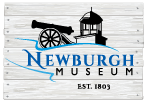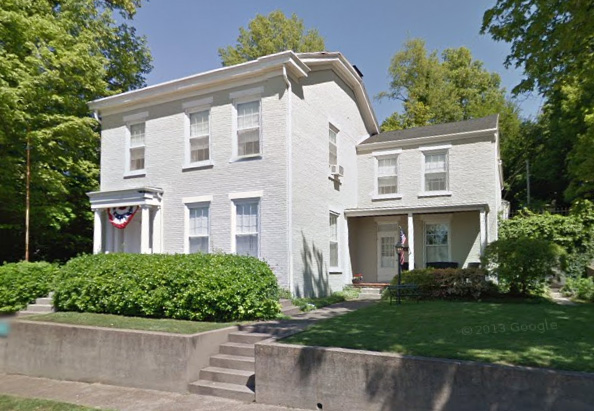18 E. Jennings St.
This large, elegant gray brick house is situated in the heart of the original town of Newburgh and was built in three sections. Abner Luce, a native of Kentucky who platted the town and was one of its first merchants, is believed to have built the first part in the 1830s in what now constitutes the east wing. He conveyed it to his son, Mathew Luce, in 1845. In 1851, Minerva Pettit (Mrs. Alexander) bought the house and with her family lived there twelve years. They presumably enlarged it considerably, probably adding the double parlors and the wide, spacious hall on the west side of the house with a beautiful staircase to the second floor.
There are four fireplaces still in the house, one in each of the double parlors, one in the bedroom over the front parlor, and one in the dining room in the east wing. One would assume Mrs. Pettit was a wealthy woman since she had the house enlarged so as to accommodate her social functions.
In 1863 Colonel Daniel F. Bates, who commanded the Warrick Legion, bought the property. This Warrick Legion included eight companies of men that defended Newburgh from the Confederates. After the famous raid on Newburgh by Adam Johnson’s guerrillas in July 1862, the story is told that there were some southern sympathizers in Newburgh who tipped off Johnson that there was an arsenal of weapons stored at the house. So after the skirmish was over in which Johnson and his men had successfully captured the guns they were after, the town was in turmoil which resulted in their taking three suspects out and hanging them. Afterwards one of the bodies was put in an old wagon and left in front of this house overnight as a lesson to other southern sympathizers. Also during the Civil War the big house became a convalescent hospital for wounded soldiers.
Daniel Frame was next in the long line of owners. The first Methodist Church services in Newburgh were held here as its owner, Mr Frame, established the first Methodist church here.
In 1898 Dr. Slaughter purchased the house for his daughter, Lillie, and her husband, Andrew J. Rutledge, a prominent lawyer. It was occupied by the Rutledge family until the death of their only daughter, Caroline. Colonel and Mrs. F. Lyle Summers purchased it from her estate in 1945. They did extensive remodeling and redecorating, making a bedroom out of the south end of the upstairs hall and adding several baths and closets to the house throughout, as well as installing two oil furnaces. They also added the beautiful entrance portico over the front door. They lived there until 1961 when it was sold to Ronald Shutz.
In 1965 Mr. and Mrs. Clay Gudgel of Evansville bought it.

